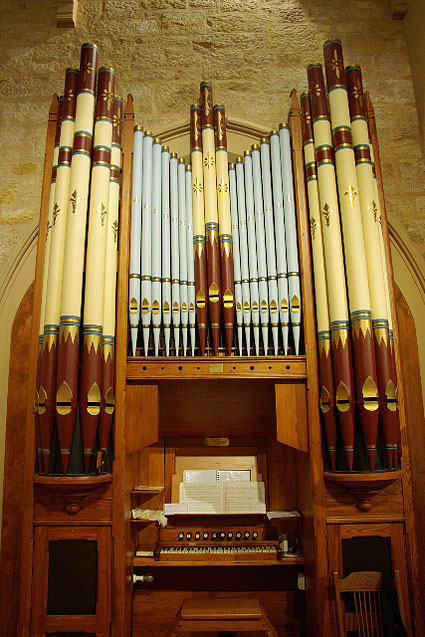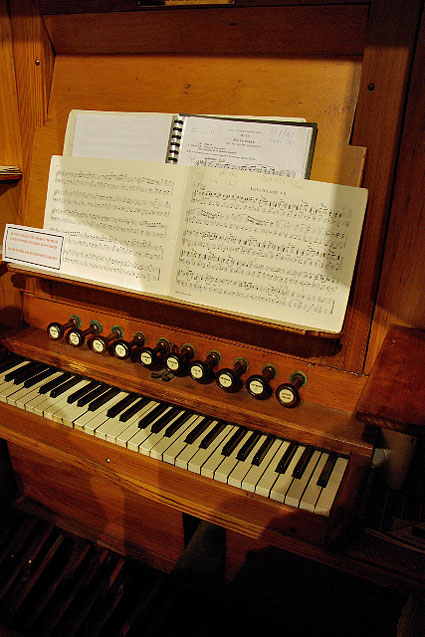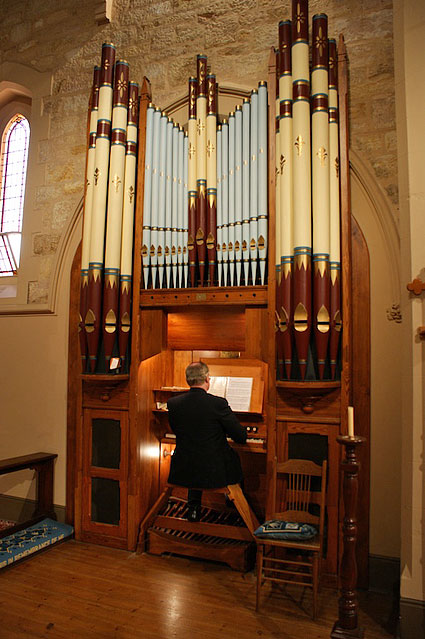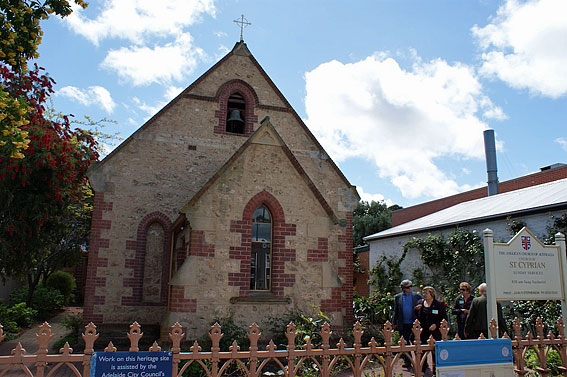St Cyprian's Anglican Church
Melbourne Street, North Adelaide
B 1882 W.G. Rendall for Holy Trinity Anglican Church, North Terrace Adelaide;
inst present loc 1927 W.L. Roberts.
1m, 8spst, 2c, tr & tub.pn.
Man: 8.8.8.8.4.4.2. Ped: 16.


Photos: PdL (2009)
From
the 2009 OHTA Conference Book,
David Shield writes:
Lower
North Adelaide in 1852 was not regarded very highly. The first nucleus of settlement on the north bank of the
River Torrens had centred on Kermode Street to the west. The population to the east, in Irish or
German Town, was regarded as “poor ignorant miscellaneous and fluctuating”,
while the area was noted for rags, filth and vermin.1 From the parish of Christ Church,
formed in 1849, a Sunday School was established in Lower North Adelaide with
the appointment of lay readers by 27 April 1851. In 1872, the present site of St Cyprian’s was purchased and
10 years later the foundation stone laid.
Called the Mission School Church it was inaugurated on 11 February 1883
by Bishop Kennion.
A
brief paragraph in 1927 noted the Dean of Adelaide, in memory of the late Revd
Charles H. Gent, had dedicated a fine organ at St Cyprian’s.2 Installed by W.L. Roberts,3
it was built by Walter George Rendall though the exact date of its construction
is still slightly uncertain. By
implication from press reports of Rendall’s work at the time, it had been
determined that the organ must have been built in 1881-82. However, renovations in 2000 revealed a
builder’s plate beneath the memorial plate of 1927 bearing the date 1880. This would seem to confirm it to be one
of Rendall’s earliest works.4
It
apparently did not work well. In
1887, Fincham & Hobday quoted £45/10/- for repairs to remake the
soundboards and action, bush the keys, put the coupler and pedal action in
order, make sound the bellows and enlarge the trunk, enlarge the conveyances to
the front pipes, new buttons, cloths, trackers and wires where necessary.5
After
documenting the organ in 1980, Stiller came to the conclusion that it was
difficult to determine the extent to which the organ was original.6 A critical article of 1897 had
indicated the instrument was:
…by no means built in accordance with the
measurements and suggestions of the Royal College of Organists, contains one
manual and a bourdon pedal. On the
manual are six stops, but the pedal is limited to the lowest twelve notes,
albeit the pedals themselves (which are quite a curiosity) extend over two
octaves.7
It
would seem at this point at least the pedal board was of 12 notes and the front
pipes were speaking pipes. By
1980, the stencilled pipes had been painted over and were non-speaking; there
was also a full pedal board of 30 notes, clearly added. Stiller also noted the diversity of
stopper shapes and suggested Rendall may have built the instrument from
second-hand pipes.
In
1949, there was a move to enlarge the organ and £100 was sought to achieve this
end. This coincided with the
retirement of the organist Mr H.L. Hill.
As a result, the wooden Viole 8ft rank was added in 1950. This rank is said to have come from the
Adastra Cinema four-rank Wurlitzer theatre organ at Port Pirie.8
George
Stephens renovated the organ in 1985.9 In 2000, the organ case and organ seat
were stripped, repaired, and revarnished.
The organ pipes were redecorated using the original colours and
stencilled pattern. The action of
the organ was thoroughly overhauled.10
W.G.
Rendall 1881-82
1
manual, 8 speaking stops, manual action mechanical,
pedal
action tubular-pneumatic
|
MANUAL |
|
|
Open Diapason |
8 |
|
Clarabel |
8 |
|
Stopped diapason |
8 |
|
Viole |
8 |
|
Principal |
4 |
|
Flute |
4 |
|
Fifteenth |
2 |
|
Octave coupler |
|
|
|
|
|
PEDAL |
|
|
Bourdon |
16 |
|
Manual to Pedal |
|
Compass: 56/30
Attached drawknob
console
Balanced swell pedal
Located in chamber to
south of chancel

Photo: PdL (2009)

Photos: JRM (Oct 2009)
1 Church Booklet: St Cyprian’s North Adelaide
Centenary Adelaide (1983), p.4
2 Register, 28 February 1927, p. 11.6. The date of 1889 given in the Church
Booklet op.cit. p.8 would appear
to be an error based on information provided to Enid Matthews by W.L. Roberts:
Matthews, E.N., Colonial Organs and Organ Builders (1969), p.193 - note 6 letter Mr Roberts to author
5 September 1965.
3 W.L. Roberts papers, order no 139b, job 103 (February 1927): cost £315
4 Further research is needed to ascertain
its acquisition by Holy Trinity.
However, through 1881 into 1882 Rendall was working on the Brougham
Place instrument. Arthur Hobday
clearly thought Rendall was disheartened and would not last long in the
profession: Fincham & Hobday
letters 12/37 (30 December 1881); ibid., 12/41 24 (January 1882): Hobday to Fincham (transcription
(incomplete) by Ronald G. Newton 1994).
Information re builders plate supplied Ralph Holden 9 May 2009. See section under Marananga re Rendall.
5 Naylor B., Organ Building in S
outh
Australia (unpublished thesis M
Mus University of Adelaide, 1973), p.255, is quoting from Dodd Letter Books
1888-1898 pp.18, 19 and 20.
Unfortunately these books are unavailable and therefore have not been
transcribed.
6 Stiller J., Documentation
St Cyprian’s Anglican Church North Adelaide Organ 7 January 1980, p.1
7 Music (May 1897), p.10.
8 Naylor, B., op.cit.
pp.684-85 quoting Adelaide Church Guardian (October 1949) and article on early Adelaide theatre organs by Baden
Pike The Vox (April May 1964),
pp.4-
5. However, this organ
does not appear in the Wurlitzer opus list at the following website: http://www.theatreorgans.com/au/opus/ and it is possible the name of the building was
the Astra Theatre. Howard Laurie
Hill OAM learnt from John Dunn at St Peter’s Cathedral. Aged 19 when appointed to St Cyprian’s,
he retired in 1949: St Cyprian’s North Adelaide Centenary Adelaide (983), pp.9, 13
9 ‘Organ Music Through
The Centuries’, OMS Newsletter,
vol 19 no 3 (March 1986), p.8
10 Information supplied Ralph Holden 9 May
2009

Photo: JRM



Photos: Rodney Ford (Oct 2009)